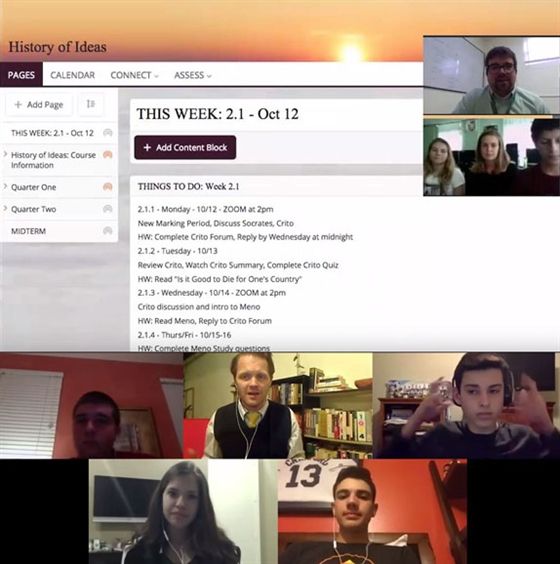

Online Learning - the High School of Everywhere
Source/Author: Adrianne Finley Odell, Assistant Head of School
April 29, 2016
One of the speakers at this year’s NAIS Annual Conference was Kevin Carey, who has written a provocative book, "The End of College." In it, Carey describes the history of higher education in America and explains what he refers to as the “hybrid college” that combines both a research university and an undergraduate educational institution. He argues that there is an innate conflict with this combination because professors in research universities are motivated to obtain grants to conduct their research so that they can publish their findings and gain tenure, rather than focusing primarily on doing an excellent job of teaching students. He believes that today’s universities are terribly inefficient and expensive, and while they are in the business of “knowledge creation” they do not have a good grasp of the true quality of the teaching that they provide as there is a lack of data on whether students are truly learning.
Carey credits Anant Agarwal, the Director of edX, an online purveyor of courses jointly founded by Harvard and MIT, as predicting that we are on the verge of a revolution—that online learning will be the single biggest change in education since the invention of the printing press. As global poverty levels decline and individuals worldwide desire to improve their situations through education, Carey believes that the number of additional people who will want to get a college education over the next twenty years could exceed the total number of people who have ever previously attended college. We have told our children that the world is changing and they will have to compete in a global marketplace, and this is true—especially as more students worldwide compete for admission to the same universities to which our children are applying. What we don’t yet know, is how much alternative educational opportunities will grow to allow students to obtain the education they desire. Carey believes that the growth in online education will rise not only to meet the demand but also to compete fiercely with existing options. He contends that the market of opportunity is just too significant and predicts that the result will be the creation of new educational options; thus, traditional colleges as we know it will no longer be able to charge the high rates of tuition that they do today. Online options will drive the prices lower, making education more accessible for many more people across the globe. In addition, programs such as Accredible.com can be leveraged by any student anywhere to create online proof of what they have learned—a tool that actually provides much more information to a prospective employer than a piece of paper from XYZ University that reads “Bachelor of Arts.”
Harvard and MIT saw this revolution coming and decided to embrace it head-on through the creation of edX, a consortium of top-tier universities that offer college courses online. Sometimes the courses are offered for free, or one can choose a paid option that results in a certificate of completion at the end of the course. While these two options are not yet directly related to obtaining a degree, these elite institutions may soon be forced to offer such programs at a lower cost to a larger consumer base to compete in the changing marketplace. If they choose this route, there is fear of brand dilution. At the same time, they could expand their market exponentially. Even though they would charge less, the volume that is generated from the potential of thousands of more individuals taking the courses would easily surpass any value lost from students not attending the school as a traditional student. This is good food for thought as were many of the points that Carey made in his book.
As I was reading, my thoughts turned to Shorecrest, what we are offering our students in terms of online learning, and what the future of education holds for them. Certainly, with the growth of this medium of instruction, our students should have opportunities to participate. We are currently in our third year of offering online classes for high school students to supplement their existing course loads. The program is described on our website, here: http://www.shorecrest.org/Page/Academics/Upper-School--9-12/Online-Learning. The idea behind the program is to give options to students who want to take a higher level course (say multivariable calculus) when they have exhausted the sequence of courses at Shorecrest. In addition, greater variety in course offerings are available as students can take courses that aren’t offered by Shorecrest faculty. Finally, students can benefit from the freedom of fitting in the work of the course outside of school hours if need be.
This year there were 33 Upper School students and one eighth grade student taking 12 different courses through the Hybrid Learning Consortium (HLC), a group of independent schools that have formed a partnership to offer high-quality online courses to their independent school students. I spoke with Chris Powers, our Director of Online Learning (and alumnus of Shorecrest), to find out more about our program. Powers researched several options for online learning programs before recommending that Shorecrest join HLC. He suggested it above other programs because Shorecrest maintains the independence to participate in the consortium as it sees fit for our school’s needs. As Powers says, “Keeping online learning at an independent school - ‘independent’ is important… I want online learning to mirror the spirit of Shorecrest versus some outside organization.”
A number of the students who took online courses this year chose this route to continue their Latin studies following the relocation of our Latin teacher. His departure as well as low enrollment in the course prompted Shorecrest to move Latin to an online option. Carter V, a junior, shared his experience:
"This year I took AP Latin (online), due to the exit of our Latin teacher Mr. Wells who moved to Georgia. The system allowed me to continue learning Latin with Mr. Wells online. The class structure was quite simple. Mr. Wells would post assignments for us on Haiku, and we would submit them to him via Haiku’s dropbox functionality. Once a week, we teleconference via a program called Zoom, which works similarly to Skype. During these meetings we would continue with course material, ask questions, and go over the details for tests. For tests, we could either take the test online, or if we wanted to take it on paper, Mr. Powers, the online coordinator, would have a paper copy available that he would scan back to Mr. Wells for grading. I like how this course gave me a sense of responsibility and independence, as there isn’t a teacher to demand that I do an assignment at that very moment. I wish my communication ability with Mr. Wells could have been better, as I would have liked to have had his phone number to ask him quick questions in the form of text messages. I feel like I learned just as much, if not more, in this online class than in a traditional setting. However, I had to apply myself more to it since I did not have a teacher to guide me. I think that online courses are of equal quality as traditional classes, as long as you work at it to keep up with the assignments on your own."
I learned that in addition to the fully online courses, there are several faculty who offer "blended" courses. These classes meet in person less frequently than other courses with the balance of time being spent online using our Haiku system and other digital software to cover the topics that are part of the syllabus. Even the fully online courses take place partly in real-time (synchronous) and partly through text discussion, wikis, lectures and voice threads that are not time dependent (asynchronous). I stopped by the Carleen Vinal Haskell Library to talk with four students who are currently enrolled in Globalization and Cultural Diversity. They explained to me that their course is scheduled into the school day just like any other course they take, except their teacher is located in Missouri. While technically these students could have chosen to do this coursework at another time of day as it is not time-dependent, they enjoyed the opportunity to meet together in the library during their assigned class time so they could discuss the topics of the course, complete assignments and collaborate. Their course is discussion-based and utilizes many online resources that the instructor references for them in Haiku. They also have projects that they have to complete as part of their course. All of the students agreed that they learned a great deal in this course, perhaps more than they might have learned in a traditional course. One student described an assignment that prompted each student to take a turn in leading a class. At first he felt that it would be easy, but as he began preparing for his turn to lead, he realized just how much work he needed to do to be able to lead well. By teaching a class, the student learned at a much deeper level.
In April of 2015, we had 78 students in our Upper School taking blended and fully online courses. We surveyed them to gain a sense of their experience and learned the following:
- 94% of the students would recommend blended and online classes to their classmates
- 91% of them agreed that blended and online learning environments enhances learning by making the process more flexible and engaging
- 89% of the students reported that blended and/or online learning provides more variety of content and differentiation in assessments
- And 88% of them agreed that these classes are comparable in rigor and expectations to a traditional class.
Julia S, a sophomore who took Latin III Honors this year, says, “I wouldn't want to be in all online classes, but having just one is great. You can work at your own pace whether it is fast or slow. You also have plenty of opportunities to learn the material since you have weekly video chats and videos of the teacher online. It has helped me a lot this year and it makes my learning experiences diverse!”
Of course there are pros and cons of taking an online course. Senior Luke P shared, “I greatly appreciate being able to take Multivariable Calculus online. It was a class that I knew I wanted to take; however, it isn't available in the traditional curriculum. I think online classes are great for exploring subjects that aren't taught at Shorecrest. I was a big fan of being able to work at my own pace. With college apps and extracurriculars, it would have been hard to balance a traditionally-taught, college level math class, but I was able to make it all work with the online class. The only problems I had were to be expected; extra help is tough to coordinate with online classes and tests were unusual (over the weekend, which often times caused issues). The inability to meet for extra help and meet more often in general partially diminished the quality in comparison to what I would've received from a traditional class. However, the class I took wasn't available in any other way, so I'm very grateful for the opportunity to participate in the online learning program.”
So, fast-forward, is the revolution that Agarwal predicts for universities going to vastly change the look of high schools in the future? Clearly, it already has. Technology is ubiquitous in classrooms throughout Shorecrest and increasingly around the country. If online learning expands in high schools the way it has at the university level, what will the role of the teacher be in the future? Perhaps there are different types of teachers for different needs of students. For many students, the future teacher they will spend the most face time with will look much more like a coach than the model that many of us Gen X or Y’ers experienced in high school and college. And the growth of technology could actually result in the need for more teachers rather than less as advancements in technology spark a need for even greater personalization and individual attention. Perhaps there will be different tiers of instructors, some who are skilled in subject areas such as high-level math or science, and who will teach a larger number of students as they benefit from online lectures and discussions led by these national and international experts. Perhaps another tier of teacher will specialize in supporting the unique learning styles of individual students. Those students could meet with these teachers a couple of times a week to delve into how they can leverage their unique strengths to benefit them in various subject areas. Much like a therapist helps someone work through emotional issues, students will work individually with these learning specialist/coaches to gain a greater understanding of how their brain works and how they can improve their performance in a variety of subjects.
It’s possible that high schools will be organized differently as well, particularly if universities alter their approach to college admissions away from high stakes testing such as the SAT and ACT (as many have already done) and more toward admitting students based on their strengths in particular subject areas, or a passion they have pursued at a deep interdisciplinary level over a number of years to gain mastery. There has been much written about the importance of 21st Century skills and that both colleges and corporations are looking for individuals who have developed strengths in creativity, critical thinking, communication, and collaboration among other areas. Yet, for the most part, universities across the country have not yet figured out how to determine aptitude in these areas so they still rely heavily on standardized test scores, GPAs, teacher recommendations and the all-important essay. As the college admissions process evolves, so will our high schools.
Perhaps the future classroom will look more like a cafe than the classroom of today? Maybe some classes in the future will actually take place at Starbucks rather than on our own campus. The ability to deliver instruction anytime/anywhere does move our society toward a “High School of Everywhere.” In fact, even today there are some fully online high schools in America for students who might benefit from that program of delivery. There will likely always be a role, however, for exceptional place-based schools in a crowded marketplace that includes online options. These schools will offer online, blended, and traditional academic experiences to students, but also provide a home-based-hub of community, deliver important affective education elements that address social and emotional health of students and positive peer interactions, offer a variety of athletic opportunities, and include programs in the performing and visual arts. As Carey states, we “need to build beautiful places, real and virtual, that learners return to throughout their lives. (We) need to create authentic human communities and form relationships with people based on the never-ending project of learning.”
Our program today at Shorecrest provides opportunities for students to learn this new online educational delivery method, offered in an environment of support as we believe that students learn best when they are provided with both challenging academics and the support to meet the challenge. And in the traditional classroom, we are exposing students to many non-traditional methods of instruction, assessment, and learning methods that will develop student’s skills in critical thinking, communication, teamwork and creativity—all of which will be instrumental to student success now and in the unknown future.
For more information on Shorecrest’s Online Learning program, contact Director of Online Learning, Chris Powers at [email protected].
























